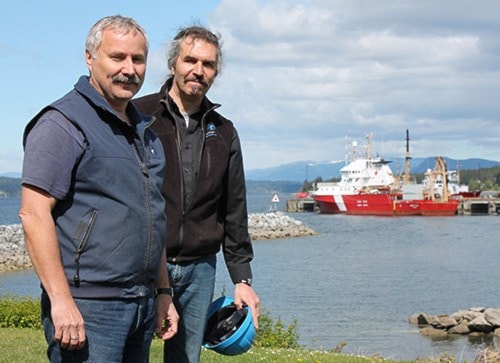Pig carcasses and killer whale communication will be some of the highlights of the latest Ocean Networks Canada (ONC) oceanographic expedition.
A team from ONC, an initiative out of the University of Victoria, departed on the Canadian Coast Guard Ship John P Tully Monday, April 29 from the Institute of Ocean Sciences at Patricia Bay. The ship will take around 17 scientists, engineers and technicians for a month long expedition which will include several different tasks.
On the first segment of the trip which will run into next week, the scientists will be pulling up two pig carcasses which have been decaying at the bottom of the Saanich Inlet and replacing them with two new ones.
The pig carcasses have been an instrumental part of a forensics experiment by Gayle Anderson and Lynne Bell of Simon Fraser University. For the last seven years, Anderson has been using the information gathered from the experiment, which is part of the VENUS ocean observatory, to help police with cases related to water decomposition including insight into the cases of feet washing up in and around the Salish Sea.
The second part of the first leg of the mission will include research on the sediment dynamics in the Fraser River delta.
"We'll be installing a whole slew of new equipment at the mouth of the Fraser River so we can study and monitor the sediment dynamics and the stability of the Fraser River slope," explained Richard Dewey, the chief scientist.
"The Fraser River delta is an area that contains lots of infrastructure, including the airport, the ferry terminal and the port in Delta. So we have a lot of interest in understanding the slope stability and what would precurse a slope failure or a major slide."
The team will also be installing hydrophones in the Strait of Georgia to monitor the resident killer whales communications and how they are affected by ship noise.
"The Strait of Georgia is a very busy shipping channel so we want to examine what, if any, effect ship noises have on killer whale communication," said Dewey.
On the second part of the expedition, ONC scientist Steve Mihaly and the science team will focus more on offshore areas including Barkley Canyon, Folger Passage and Effingham Inlet fjord.
Mihaly and the team will conduct maintenance on some of the NEPTUNE ocean observatory equipment as well installing new equipment that will measure oxygen, track vocalizing sea mammals and monitor the growth of gas hydrate mounds.
"We'll also be looking at the oxygen content of deep, low-oxygen water and how the ecology reacts to it," explained Mihaly, adding that a warmer climate and warmer waters could eventually lead to lower oxygen levels all around.
The trip, which returns to the Institute of Ocean Sciences on May 28, is the first of eight expeditions on five ships that will happen over the summer season. Federal funding for the trips, which Dewey estimated to come in around $13 million, comes from the Canada Foundation for Innovation.
For more information or to view the cameras associated with the VENUS and NEPTUNE ocean observatories, visit www.oceannetworks.ca.
reporter@peninsulanewsreview.com
